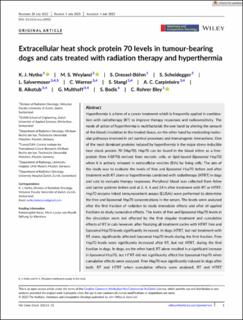Please use this identifier to cite or link to this item:
https://doi.org/10.21256/zhaw-28611| Publication type: | Article in scientific journal |
| Type of review: | Peer review (publication) |
| Title: | Extracellular heat shock protein 70 levels in tumour-bearing dogs and cats treated with radiation therapy and hyperthermia |
| Authors: | Nytko, K. J. Weyland, M. Dressel-Böhm, S. Scheidegger, S. Salvermoser, L. Werner, C. Stangl, S. Carpinteiro, A. C. Alkotub, B. Multhoff, G. Bodis, S. Rohrer Bley, C. |
| et. al: | No |
| DOI: | 10.1111/vco.12923 10.21256/zhaw-28611 |
| Published in: | Veterinary and Comparative Oncology |
| Volume(Issue): | 21 |
| Issue: | 4 |
| Page(s): | 605 |
| Pages to: | 615 |
| Issue Date: | 31-Aug-2023 |
| Publisher / Ed. Institution: | Wiley |
| ISSN: | 1476-5810 1476-5829 |
| Language: | English |
| Subjects: | Cancer; Canine; Feline; Liposomal Hsp70; Radiotherapy; Thermoradiotherapy |
| Subject (DDC): | 630: Agriculture |
| Abstract: | Hyperthermia is a form of a cancer treatment which is frequently applied in combination with radiotherapy (RT) to improve therapy responses and radiosensitivity. The mode of action of hyperthermia is multifactorial; the one hand by altering the amount of the blood circulation in the treated tissue, on the other hand by modulating molecular pathways involved in cell survival processes and immunogenic interactions. One of the most dominant proteins induced by hyperthermia is the major stress-inducible heat shock protein 70 (Hsp70). Hsp70 can be found in the blood either as a free-protein (free HSP70) derived from necrotic cells, or lipid-bound (liposomal Hsp70) when it is actively released in extracellular vesicles (EVs) by living cells. The aim of the study was to evaluate the levels of free and liposomal Hsp70 before and after treatment with RT alone or hyperthermia combined with radiotherapy (HTRT) in dogs and cats to evaluate therapy responses. Peripheral blood was collected from feline and canine patients before and at 2, 4, 6 and 24 h after treatment with RT or HTRT. Hsp70 enzyme-linked immunosorbent assays (ELISAs) were performed to determine the free and liposomal Hsp70 concentrations in the serum. The levels were analysed after the first fraction of radiation to study immediate effects and after all applied fractions to study cumulative effects. The levels of free and liposomal Hsp70 levels in the circulation were not affected by the first singular treatment and cumulative effects of RT in cats however, after finalizing all treatment cycles with HTRT free and liposomal Hsp70 levels significantly increased. In dogs, HTRT, but not treatment with RT alone, significantly affected liposomal Hsp70 levels during the first fraction. Free Hsp70 levels were significantly increased after RT, but not HTRT, during the first fraction in dogs. In dogs, on the other hand, RT alone resulted in a significant increase in liposomal Hsp70, but HTRT did not significantly affect the liposomal Hsp70 when cumulative effects were analysed. Free Hsp70 was significantly induced in dogs after both, RT and HTRT when cumulative effects were analysed. RT and HTRT treatments differentially affect the levels of free and liposomal Hsp70 in dogs and cats. Both forms of Hsp70 could potentially be further investigated as potential liquid biopsy markers to study responses to RT and HTRT treatment in companion animals. |
| URI: | https://digitalcollection.zhaw.ch/handle/11475/28611 |
| Fulltext version: | Published version |
| License (according to publishing contract): | CC BY-NC-ND 4.0: Attribution - Non commercial - No derivatives 4.0 International |
| Departement: | School of Engineering |
| Organisational Unit: | Institute of Applied Mathematics and Physics (IAMP) |
| Appears in collections: | Publikationen School of Engineering |
Files in This Item:
| File | Description | Size | Format | |
|---|---|---|---|---|
| 2023_Nytko-etal_Hsp70-radiation-therapy-and-hyperthermia-treatment.pdf | 1.59 MB | Adobe PDF |  View/Open |
Show full item record
Nytko, K. J., Weyland, M., Dressel-Böhm, S., Scheidegger, S., Salvermoser, L., Werner, C., Stangl, S., Carpinteiro, A. C., Alkotub, B., Multhoff, G., Bodis, S., & Rohrer Bley, C. (2023). Extracellular heat shock protein 70 levels in tumour-bearing dogs and cats treated with radiation therapy and hyperthermia. Veterinary and Comparative Oncology, 21(4), 605–615. https://doi.org/10.1111/vco.12923
Nytko, K.J. et al. (2023) ‘Extracellular heat shock protein 70 levels in tumour-bearing dogs and cats treated with radiation therapy and hyperthermia’, Veterinary and Comparative Oncology, 21(4), pp. 605–615. Available at: https://doi.org/10.1111/vco.12923.
K. J. Nytko et al., “Extracellular heat shock protein 70 levels in tumour-bearing dogs and cats treated with radiation therapy and hyperthermia,” Veterinary and Comparative Oncology, vol. 21, no. 4, pp. 605–615, Aug. 2023, doi: 10.1111/vco.12923.
NYTKO, K. J., M. WEYLAND, S. DRESSEL-BÖHM, S. SCHEIDEGGER, L. SALVERMOSER, C. WERNER, S. STANGL, A. C. CARPINTEIRO, B. ALKOTUB, G. MULTHOFF, S. BODIS und C. ROHRER BLEY, 2023. Extracellular heat shock protein 70 levels in tumour-bearing dogs and cats treated with radiation therapy and hyperthermia. Veterinary and Comparative Oncology. 31 August 2023. Bd. 21, Nr. 4, S. 605–615. DOI 10.1111/vco.12923
Nytko, K. J., M. Weyland, S. Dressel-Böhm, S. Scheidegger, L. Salvermoser, C. Werner, S. Stangl, et al. 2023. “Extracellular Heat Shock Protein 70 Levels in Tumour-Bearing Dogs and Cats Treated with Radiation Therapy and Hyperthermia.” Veterinary and Comparative Oncology 21 (4): 605–15. https://doi.org/10.1111/vco.12923.
Nytko, K. J., et al. “Extracellular Heat Shock Protein 70 Levels in Tumour-Bearing Dogs and Cats Treated with Radiation Therapy and Hyperthermia.” Veterinary and Comparative Oncology, vol. 21, no. 4, Aug. 2023, pp. 605–15, https://doi.org/10.1111/vco.12923.
Items in DSpace are protected by copyright, with all rights reserved, unless otherwise indicated.